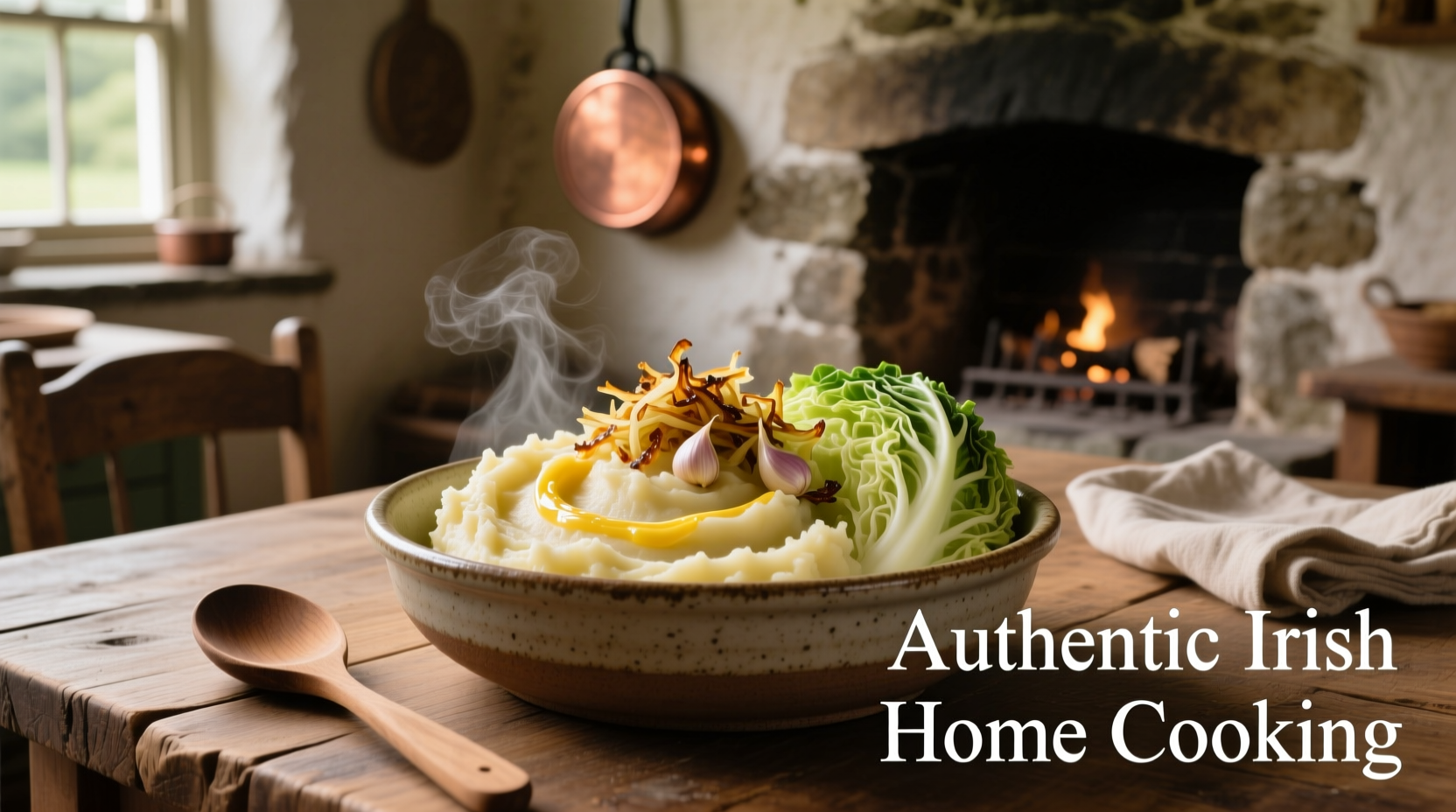What Exactly Is Irish Mash Potato with Cabbage?
While often searched as "irish mash potato with cabbage," this dish has a proper name: Colcannon. Originating in Ireland, Colcannon (from the Gaelic "cál ceann fholamh," meaning "white-headed cabbage") combines mashed potatoes with cooked cabbage or kale, creating a hearty side dish that's both economical and nutritious. Unlike American mashed potato variations, authentic Irish Colcannon features specific preparation techniques that preserve the distinct textures of each component while allowing flavors to meld perfectly.
| Traditional vs. Modern Colcannon | Traditional Preparation | Common Modern Variations |
|---|---|---|
| Potato Type | Russet or Irish floury potatoes | Yukon Gold, red potatoes |
| Greens Used | Spring cabbage or curly kale | Collard greens, savoy cabbage |
| Seasoning Base | Scallions, black pepper, butter | Garlic, bacon, cheese |
| Cooking Liquid | Milk or buttermilk | Cream, stock |
The Historical Roots of Colcannon
Colcannon's history stretches back centuries in Irish culinary tradition. During the 18th and 19th centuries, when potatoes formed the staple diet for most Irish families, cabbage provided essential nutrients during lean times. The Kildare County Museum documents how Irish households would prepare Colcannon using whatever greens were seasonally available, making it a practical dish that minimized food waste. Originally served as a main course rather than a side, Colcannon gained special significance around Halloween, when families would hide small tokens in the dish to predict fortunes for the coming year—a tradition still observed in some Irish households today.

Essential Ingredients for Authentic Flavor
The magic of proper Irish mash potato with cabbage lies in ingredient selection. Unlike American versions that might add cheese or bacon, traditional Colcannon relies on quality basics:
- Potatoes: Floury varieties like Rooster or Kerr's Pink (common in Ireland) or Russets (easily available internationally) provide the ideal fluffy texture
- Cabbage: Spring cabbage offers the sweetest flavor, but savoy cabbage works well as substitute
- Scallions: Essential for authentic flavor—never substitute with regular onions
- Butter and milk: Use unsalted butter and whole milk for creaminess without overpowering
Step-by-Step Preparation Guide
Follow these steps for perfect Irish mash potato with cabbage that maintains the distinct textures while blending flavors:
- Prepare potatoes: Peel and cube 2 lbs potatoes, boil in salted water until fork-tender (15-20 minutes)
- Cook greens: While potatoes boil, finely shred 1/2 small cabbage and simmer in separate pot with 1/4 cup milk for 8-10 minutes
- Drain thoroughly: Critical step—excess water makes Colcannon gluey. Drain potatoes well and return to warm pot
- Mash potatoes: Use potato ricer or masher (not food processor!) with 3 tbsp butter and 1/4 cup warm milk
- Combine: Gently fold cooked cabbage and 4 sliced scallions into potatoes—don't overmix
- Season: Add salt and freshly ground black pepper to taste
Avoiding Common Mistakes
Many home cooks ruin authentic Irish mash potato with cabbage by making these errors:
- Overmixing: Creates gummy texture—fold ingredients gently
- Wet ingredients: Ensure both potatoes and cabbage are well-drained
- Wrong greens: Avoid bitter greens like mature kale—spring cabbage is traditional
- Insufficient seasoning: Potatoes need generous salting during boiling
Regional Variations Across Ireland
While searching for irish mash potato with cabbage recipes, you'll notice regional differences. In Ulster, some versions include chopped ham, while Munster preparations often feature more scallions. The Bord Bia (Irish Food Board) documents how coastal communities sometimes add a splash of buttermilk for tanginess, reflecting local dairy traditions. These variations all maintain the essential character of Colcannon while adapting to local preferences—a testament to the dish's versatility within Irish culinary heritage.
When and How to Serve Authentic Colcannon
Traditionally served as a main course with brown bread, modern Irish households typically present Colcannon as a side dish alongside:
- Irish stew (lamb or beef)
- Pan-fried salmon
- Roast chicken with herbs
- As part of a full Irish breakfast
For special occasions like Halloween, some Irish families still follow the tradition of placing a ring or coin in the Colcannon—finding it predicts marriage or financial luck in the coming year. This practice, documented by the Dublin Institute for Advanced Studies, shows how food traditions intertwine with cultural celebrations.
Expert Tips for Perfect Texture and Flavor
As a European cuisine specialist, I've refined these techniques through years of studying traditional Irish cooking methods:
- Warm dairy: Always use warmed milk/butter to prevent potatoes from becoming gluey
- Reserve cooking liquid: Save 2 tbsp cabbage cooking liquid to adjust consistency if needed
- Layer flavors: Sauté scallions in butter before adding to potatoes for deeper flavor
- Resting time: Let Colcannon sit 5 minutes before serving—flavors meld beautifully
Frequently Asked Questions
Is Colcannon the same as Irish mash potato with cabbage?
Yes, Colcannon is the traditional Irish name for mashed potatoes mixed with cabbage or kale. While often searched as "irish mash potato with cabbage," Colcannon specifically refers to this authentic preparation method that's been part of Irish cuisine for centuries.
What's the difference between Colcannon and bubble and squeak?
Colcannon mixes mashed potatoes with fresh cabbage during preparation, while bubble and squeak is a British dish made by frying leftover mashed potatoes and cooked cabbage together. Colcannon has a creamier texture and is served immediately, whereas bubble and squeak creates a crispy pancake from leftovers.
Can I make authentic Irish mash potato with cabbage vegan?
Yes, traditional Colcannon can easily be made vegan by substituting butter with vegan alternative and using plant-based milk. Many historical Irish preparations were naturally vegan during religious fasting periods, using only potatoes, cabbage, and water.
How do I store and reheat leftover Colcannon?
Store leftovers in an airtight container in the refrigerator for up to 3 days. Reheat gently in a saucepan with a splash of milk, stirring frequently. Avoid microwaving which can make the potatoes gummy. For best results, spread leftovers in an oven-safe dish, dot with butter, and bake at 350°F until heated through.











 浙公网安备
33010002000092号
浙公网安备
33010002000092号 浙B2-20120091-4
浙B2-20120091-4